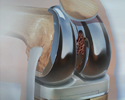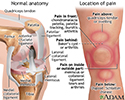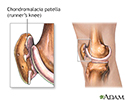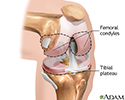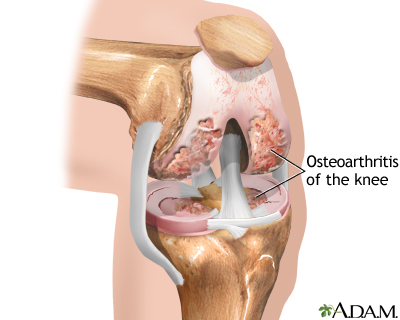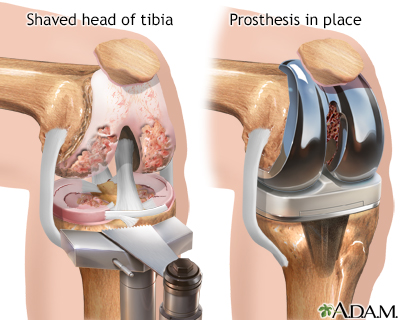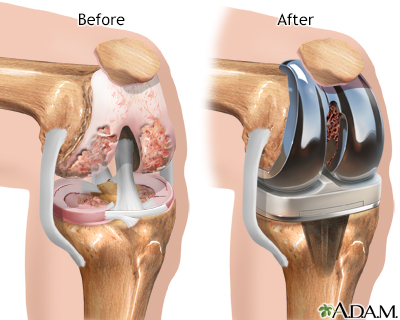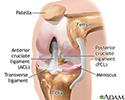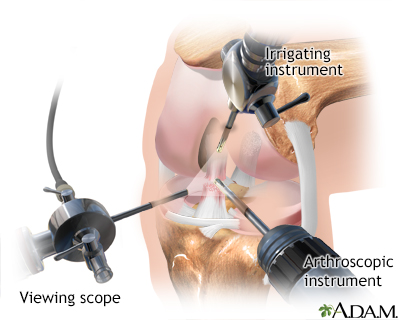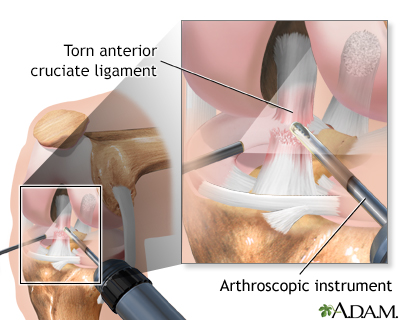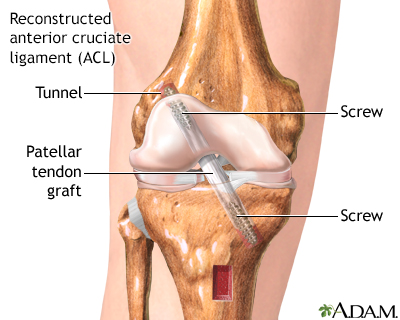Knee pain
Pain - kneeKnee pain is a common symptom in people of all ages. It may start suddenly, often after an injury or exercise. Knee pain also may begin as a mild discomfort, then slowly get worse.
The Basics
Tests for knee pain
Knee joint replacement - Animation
Knee joint replacement
Animation
Knee pain
The location of knee pain can help identify the problem. Pain on the front of the knee can be due to bursitis, arthritis, or softening of the patella cartilage as in chondromalacia patella. Pain on the sides of the knee is commonly related to injuries to the collateral ligaments, arthritis, or tears to the meniscuses. Pain in the back of the knee can be caused by arthritis or cysts, known as Baker's cysts. Baker's cysts are an accumulation of joint fluid (synovial fluid) that forms behind the knee. Overall knee pain can be due to bursitis, arthritis, tears in the ligaments, osteoarthritis of the joint, or infection.
Knee pain
illustration
Runners knee
Chondromalacia causes knee tenderness, knee pain in front of the knee, and a grating sensation in the knee. The knee pain is worst after sitting for a prolonged period of time or when getting out of a chair. The knee cartilage is affected probably from overuse, trauma and/or abnormal forces on the knee, such as a misaligned patella. Chondromalacia is treated with rest or immobilization and nonsteroidal anti-inflammatory drugs for pain. Physical therapy, especially quadriceps strengthening and hamstring stretching may also be helpful. Surgery is beneficial if there is a problem with the alignment of the patella that cannot be corrected with therapy.
Runners knee
illustration
Knee joint replacement - series
Presentation
Knee arthroscopy - series
Presentation
Knee pain
The location of knee pain can help identify the problem. Pain on the front of the knee can be due to bursitis, arthritis, or softening of the patella cartilage as in chondromalacia patella. Pain on the sides of the knee is commonly related to injuries to the collateral ligaments, arthritis, or tears to the meniscuses. Pain in the back of the knee can be caused by arthritis or cysts, known as Baker's cysts. Baker's cysts are an accumulation of joint fluid (synovial fluid) that forms behind the knee. Overall knee pain can be due to bursitis, arthritis, tears in the ligaments, osteoarthritis of the joint, or infection.
Knee pain
illustration
Runners knee
Chondromalacia causes knee tenderness, knee pain in front of the knee, and a grating sensation in the knee. The knee pain is worst after sitting for a prolonged period of time or when getting out of a chair. The knee cartilage is affected probably from overuse, trauma and/or abnormal forces on the knee, such as a misaligned patella. Chondromalacia is treated with rest or immobilization and nonsteroidal anti-inflammatory drugs for pain. Physical therapy, especially quadriceps strengthening and hamstring stretching may also be helpful. Surgery is beneficial if there is a problem with the alignment of the patella that cannot be corrected with therapy.
Runners knee
illustration
Knee joint replacement - series
Presentation
Knee arthroscopy - series
Presentation
Knee pain
Pain - kneeKnee pain is a common symptom in people of all ages. It may start suddenly, often after an injury or exercise. Knee pain also may begin as a mild discomfort, then slowly get worse.
The Basics
Tests for knee pain
Knee pain
Pain - kneeKnee pain is a common symptom in people of all ages. It may start suddenly, often after an injury or exercise. Knee pain also may begin as a mild discomfort, then slowly get worse.
The Basics
Tests for knee pain
Review Date: 12/12/2022
Reviewed By: C. Benjamin Ma, MD, Professor, Chief, Sports Medicine and Shoulder Service, UCSF Department of Orthopaedic Surgery, San Francisco, CA. Also reviewed by David C. Dugdale, MD, Medical Director, Brenda Conaway, Editorial Director, and the A.D.A.M. Editorial team.

